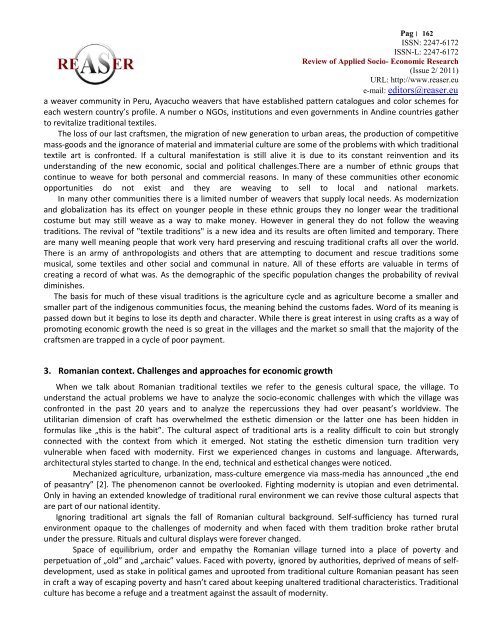Volume 2, ISSUE2/2011 - Review of Applied Socio-Economic ...
Volume 2, ISSUE2/2011 - Review of Applied Socio-Economic ...
Volume 2, ISSUE2/2011 - Review of Applied Socio-Economic ...
You also want an ePaper? Increase the reach of your titles
YUMPU automatically turns print PDFs into web optimized ePapers that Google loves.
Pag׀ 162 ISSN: 2247-6172ISSN-L: 2247-6172<strong>Review</strong> <strong>of</strong> <strong>Applied</strong> <strong>Socio</strong>- <strong>Economic</strong> Research(Issue 2/ <strong>2011</strong>)URL: http://www.reaser.eue-mail: editors@reaser.eua weaver community in Peru, Ayacucho weavers that have established pattern catalogues and color schemes foreach western country’s pr<strong>of</strong>ile. A number o NGOs, institutions and even governments in Andine countries gatherto revitalize traditional textiles.The loss <strong>of</strong> our last craftsmen, the migration <strong>of</strong> new generation to urban areas, the production <strong>of</strong> competitivemass-goods and the ignorance <strong>of</strong> material and immaterial culture are some <strong>of</strong> the problems with which traditionaltextile art is confronted. If a cultural manifestation is still alive it is due to its constant reinvention and itsunderstanding <strong>of</strong> the new economic, social and political challenges.There are a number <strong>of</strong> ethnic groups thatcontinue to weave for both personal and commercial reasons. In many <strong>of</strong> these communities other economicopportunities do not exist and they are weaving to sell to local and national markets.In many other communities there is a limited number <strong>of</strong> weavers that supply local needs. As modernizationand globalization has its effect on younger people in these ethnic groups they no longer wear the traditionalcostume but may still weave as a way to make money. However in general they do not follow the weavingtraditions. The revival <strong>of</strong> "textile traditions" is a new idea and its results are <strong>of</strong>ten limited and temporary. Thereare many well meaning people that work very hard preserving and rescuing traditional crafts all over the world.There is an army <strong>of</strong> anthropologists and others that are attempting to document and rescue traditions somemusical, some textiles and other social and communal in nature. All <strong>of</strong> these efforts are valuable in terms <strong>of</strong>creating a record <strong>of</strong> what was. As the demographic <strong>of</strong> the specific population changes the probability <strong>of</strong> revivaldiminishes.The basis for much <strong>of</strong> these visual traditions is the agriculture cycle and as agriculture become a smaller andsmaller part <strong>of</strong> the indigenous communities focus, the meaning behind the customs fades. Word <strong>of</strong> its meaning ispassed down but it begins to lose its depth and character. While there is great interest in using crafts as a way <strong>of</strong>promoting economic growth the need is so great in the villages and the market so small that the majority <strong>of</strong> thecraftsmen are trapped in a cycle <strong>of</strong> poor payment.3. Romanian context. Challenges and approaches for economic growthWhen we talk about Romanian traditional textiles we refer to the genesis cultural space, the village. Tounderstand the actual problems we have to analyze the socio-economic challenges with which the village wasconfronted in the past 20 years and to analyze the repercussions they had over peasant’s worldview. Theutilitarian dimension <strong>of</strong> craft has overwhelmed the esthetic dimension or the latter one has been hidden informulas like „this is the habit”. The cultural aspect <strong>of</strong> traditional arts is a reality difficult to coin but stronglyconnected with the context from which it emerged. Not stating the esthetic dimension turn tradition veryvulnerable when faced with modernity. First we experienced changes in customs and language. Afterwards,architectural styles started to change. In the end, technical and esthetical changes were noticed.Mechanized agriculture, urbanization, mass-culture emergence via mass-media has announced „the end<strong>of</strong> peasantry” [2]. The phenomenon cannot be overlooked. Fighting modernity is utopian and even detrimental.Only in having an extended knowledge <strong>of</strong> traditional rural environment we can revive those cultural aspects thatare part <strong>of</strong> our national identity.Ignoring traditional art signals the fall <strong>of</strong> Romanian cultural background. Self-sufficiency has turned ruralenvironment opaque to the challenges <strong>of</strong> modernity and when faced with them tradition broke rather brutalunder the pressure. Rituals and cultural displays were forever changed.Space <strong>of</strong> equilibrium, order and empathy the Romanian village turned into a place <strong>of</strong> poverty andperpetuation <strong>of</strong> „old” and „archaic” values. Faced with poverty, ignored by authorities, deprived <strong>of</strong> means <strong>of</strong> selfdevelopment,used as stake in political games and uprooted from traditional culture Romanian peasant has seenin craft a way <strong>of</strong> escaping poverty and hasn’t cared about keeping unaltered traditional characteristics. Traditionalculture has become a refuge and a treatment against the assault <strong>of</strong> modernity.








